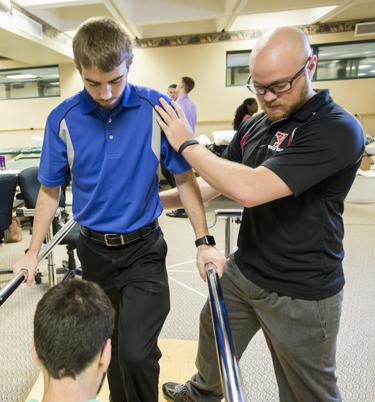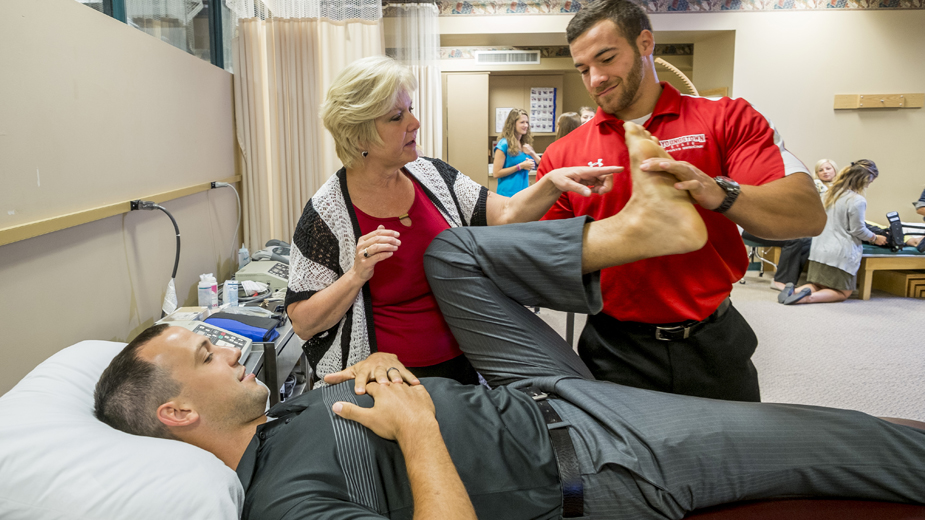YOUNGSTOWN, Ohio – Having a local physical therapy doctoral program feeds the workforce pipeline with graduates who bring “a little bit extra” to their work.
That extra is a connection to the community, says Dr. Meghan Ball, specialist in pediatrics physical therapy at Akron Children’s Hospital Beeghly Campus in Boardman. Students who feel they have been served well by the community want to give back, she says.
“Even those coming from out-of-state who aren’t initially part of the community, they feel that and they kind of embrace that as well,” Ball says. “They care about the right things. And that’s reflected in the care the students show when they work with patients.”
Ball is an adjunct instructor for the doctor of physical therapy, or DPT, program at Youngstown State University’s Bitonte College of Health and Human Services. Of the four physical therapists in her department at Akron Children’s, two are YSU graduates who were her students. “It’s nice to start establishing that relationship early,” she says.
In 2008, the PT doctoral program was approved by the Higher Learning Commission, becoming the university’s third doctoral program, says Dr. Nancy Landgraff, chairwoman of YSU’s department of physical therapy.

Initially, YSU started with a baccalaureate program in 1996, but had to push to a doctoral level per the national trend. “Only doctoral programs now are accredited,” Landgraff says.
Today the program allows a maximum of 45 students in each of three cohorts, up from 20 in 2008, for a total of 135 physical therapy students at any one time. Landgraff and Dr. Cara Berg-Carramusa, assistant professor and clinical education coordinator for the DPT program, worked together on increasing that capacity and establishing the curriculum.
“That took a big renovation and commitment from the university,” Landgraff says. “Our lab size was big enough to accommodate more students, but our classroom sizes were not. We went through renovation and expansion so we could accommodate 45 students and increase enrollment.”
From its inception, the physical therapy program has graduated “well over 500,” many of whom have stayed within the region, Landgraff says. As more students graduate from the program, there’s a concern if there will be enough jobs for them. With 12 physical therapy schools in Ohio, the state is “a really competitive area,” she says.
“But when you look nationally, there’s still pockets of places where there’s a huge need in therapy,” Landgraff says, particularly with traveling organizations that go from place to place.
Locally, she expects a wave of retirements in the next five to 10 years, creating employment opportunities for the workforce, she notes.
Industry trends will also increase the need for physical therapy doctors in the Cleveland to Pittsburgh corridor, says Berg-Carramusa. Geriatric physical therapy is one area in which she sees the potential for growth.
“Our area is densely populated with such folks that somebody’s got to be taking care of them,” Berg-Carramusa says.
Other trends, such as telehealth, cash-based practices and the ongoing opioid epidemic also present opportunities, she says.
A number of YSU graduates have opened cash-based practices in the area and offer services such as CrossFit training, women’s health and pelvic health, as well as care for lymphedema and post-mastectomy patients, she says.
“A lot of people are willing to go to that cash-based service and pay for it when it makes a lot of sense,” Landgraff says. “Insurance kind of drives up the cost. And it can be just an easier managed thing.”
One of the biggest trends in the industry is population health, Landgraff says. The trend relies on a transdisciplinary approach to health care to benefit multiple health determinants of a community.
For example, stroke survivors are usually limited in their mobility, reducing their physical activity, she says. That lack of exercise can negatively affect certain risk factors, such as high blood pressure and high cholesterol, which need to be kept in check to prevent another stroke.
While medicine has traditionally been more reactive than active, population health is refocusing the mindset to caring for oneself today to prevent certain issues down the road, Berg-Carramusa says.
“It’s shifted the perspective of our practice because a lot of times people think about physical therapy in the aftermath,” she says.
Berg-Carramusa helped to start the Walk with a Doc program at the Southern Park Mall in Boardman. The monthly program includes an educational talk on a relevant health topic by a featured expert, who then leads the group in a walk around the mall. Participants can ask questions during the walk and receive blood pressure and heart rate checks pre- and post-walk by YSU DPT students.
The physical therapy department at Mercy Health-Youngstown employs some 25 YSU graduates and provides clinical opportunities for current students as well, says John Capple, Mercy’s service line director of rehab services, neuroscience and occupational health. A graduate of YSU’s physical therapy program himself, employing YSU graduates has “always been a source of pride for me,” he says.
“We have five to eight students at any given time during the year from Youngstown State University and are preparing them on the inpatient side of the hospital as well as the outpatient clinics,” Capple says.
Mercy operates seven outpatient clinics, including two it added in Columbiana and Boardman in the last few years. “We have plans for several more” all over the market, he says.
For each new clinic, Mercy typically hires one or two new clinicians. In-patient opportunities are “rapidly growing” as well, Capple says.
“There will always be a need for that service as well throughout our three hospitals in the Youngstown market,” Capple says. “The overall perception and what I believe is we’re going to see a pretty sustainable health care market overall. And as a subsector, physical therapy services will do very well and thrive in the area.”
Akron Children’s Ball agrees, saying that as physical therapy programs at the children’s hospital develop, and as more people become aware of the benefits PT can offer kids, “There’s definitely room to grow,” she says.
Sports injury and concussion treatment is “rapidly advancing” for children’s health, Ball says.
“The earlier we address some of the issues of childhood, the less they have an impact for their future,” she says. “It’s definitely a snowball effect, where if you have something small it can continue to grow.”
That approach extends to the neonatal intensive care unit, where encouraging good posture and movement among premature infants can “carry on into their future,” Ball says.
Akron Children’s is working with YSU to develop a pipeline for employment and research. The children’s hospital provides clinical opportunities at its Boardman and Warren/Howland campuses, as well as the Rich Center for Autism during non-COVID times.
“A lot of fields are looking for people that have some experience,” she says. “If we have that relationship and know what that student is all about, we know they can be successful.”
Local job opportunities begin with clinical partners. Of all the clinical instructors in the area YSU works with, 65% are university graduates, says YSU’s Landgraff. “When you have that many alumni out there, you can build that network of support.”
Students do their clinicals at larger health systems, such as Mercy, Akron Children’s, Cleveland Clinic and Steward Medical Group, as well as smaller, private practices, Berg-Carramusa says. Clinicals are held in six-, nine- and 15-week periods, with the longer two typically for students who have completed their classroom work. Such partnerships are vital for local workforce development, she says.
“That’s a nine- or 15-week interview with them,” she says. “They know how they work with their team. They know how they work with their patients. A lot of our students actually get tagged while they’re on clinical.”
Pictured: Dr. Nancy Landgraff, chairwoman of Youngstown State University’s department of physical therapy, instructs Anthony Schiraldi and Josh Osborn. Both graduated from the doctoral program and are now employed locally.
